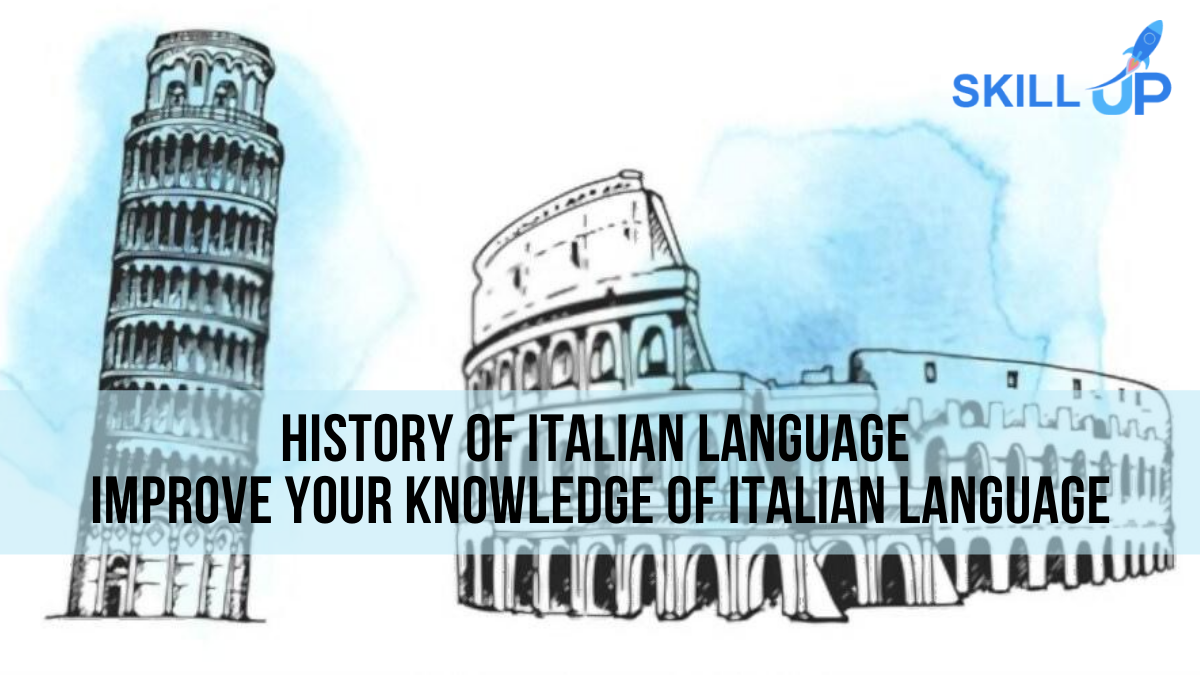
History of Italian Language is a bit young compared to the UN official languages (Arabic, Chinese, English, French, Russian and Spanish). Originating from Latin roots, the Italian language has become an important medium to the World Economy, Business, Politics and Culture. A study shows that in The US institutions, Italian is the 6th most learned language. There were 56,743 enrollments in 2016, about 4.0% of total students. You will fall in love with Italian once you get to know Italian Language History. This blog has explained in detail about the history of the Italian language and dialects.
History of Italian Language
For ease, we can divide the history in 3 sections and some subsections. It will be easier if you know the origin of the language first, then the development and the modern era.
Origin of Italian Language
As you know, Italian is not an ancient language compared to the big 6, but the parent language has greatly influenced Italian. Let’s take a look.
Ancient Root
Italian descended directly from the Vulgar Latin or popularly known as Romance Language. Italian is the second most spoken language in Europe. A young Indo-European language that has roots in Latin. If you look into language articles, you will be amazed to see that Italian is the closest language to Latin.
Medieval Age
During the 5th to 15th centuries, Latin was the official language in most of Europe. Although most of the residents were illiterate, Latin was written and read by a handful of people. The rest used a language that you know as Vulgar Latin or spoken Latin.
Like Arabic and Hebrew, both came from the Semitic language of Abraham. Latin then had different accents over Europe. Later on, spoken Latin became Portuguese, Spanish, French, Italian, Catalan, and many more.
Italian first came into existence of standard writing in the 12th century. Tuscan (central Italy) writers’ poems and literature gave shape to the Italian language. However, you will see the Italian grammar and core lexicon have not changed since the 13th-century use by Florence (Capital of Tuscan).
Written Form of Italian Language
Dante Alighieri wrote the most popularly practiced literature in the 14th century. A Tuscan writer who wrote the poems collectively known as the Commedia. If you study Italian literature, you will see the influence and depth of this literature. From that period, the Italian Peninsula used the standards of ‘the Commedia’ as their written form.
Italian Scholars consider Dante as the father of Italian language. However, his political and cultural significance has worked in his favor. But Dante’s linguistic approach became an intermediary between North and South Italian communication.
Renaissance
The Italian renaissance might attract you. Below you will see several reasons for Italian rebirth. Many of these causes are related to religious, political, and literature influence.
Italian Bible
Unlike the other Abrahamic religious scriptures, the Bible was not translated into Indo-Italian languages other than English. Petrarch, the famous Italian Artist, blamed the ‘dark ages’ of Europe for this. In the 16th century, the Roman Catholic Church excommunicated Martin Luther. He became an aftermath priest known for his different thoughts in Biblical matters.
Luther created a section in Catholicism and translated the Bible in many European languages. The printing press by Johannes Gutenberg emphasized Italian translation for access to a large number of people around Europe. The reason was simple. Italian is the closest language to Latin.
Official and Court Language
After some years, Italian became the court language in Italian peninsula city-states. It gave Italian a boost to be practised widely throughout the states.
Rediscovery and Division of Scholars
After the scholars rediscovered Dante’s De vulgari eloquentia, the scholars divided into three groups. They wanted a regular basis that should govern future Italian literature. The scholarly groups are-
- The purist head Venetian Pietro Bembo believed that Italian might be based only on the great literary classics. The classics that were written by Petrarch and Boccaccio.The purists thought the Divine Comedy (Dante’s the Commedia) was not good enough as Dante used non-lyric elements of the language.
- Some scholars, such as Niccolò Machiavelli and other Florentines, preferred the spoken language of Tuscan people in their times.
- Like Baldassare Castiglione and Gian Giorgio Trissino, some courtiers wanted each local vernacular to contribute to the new standard of Italian.
First Italian Dictionary and Printing Press Growth
After a century-long debate, Bembo’s Idea prevailed to be victorious and realistic. Accademia della Crusca published the first Italian dictionary in 1612. The publication of Floris italicae linguae libri novem by Agnolo Monosini in 1604 inspired the dictionary authorization.
The growth of the printing press played a major role for the Italian to reach where you see it. By the end of the 15th century, Italy had the most number of printing presses in Europe. With 56 active presses, It excelled in the publication of literature to general people quickly and cheaply.
Expansion and Italianization
The conquest of Napoleon pushed the language to be the official language in courts and provinces. He was an Italian-Corsican descent. After some decades, Italian became not just the clerical language but also the lingua franca for unified Italy.
Italian Language Learning Tips
The Italian language can be prosperous. You can learn Italian in different online platforms. But before going there, read some free tips that might come in handy. You can also read this blog to get in depth tips about learning Italian language. The best way to learn Italian language is to-
- Find similarities between Italian and Latin born languages
- Study the greetings and simple sentences to wet your feet
- Understand the pronunciation of Alphabets and Words
- Study the verbs and Verb endings to dive deeper
- List only the necessary words for formal use
- Avoid unnecessary vocabulary (organ names, fruit names)
- Don’t be afraid or ashamed of making mistakes
- Make mistakes but correct them instantly
- Get mentally prepared to learn new grammar
- Do not rush in learning the language
- Do not rush in learning the language
- Avoid translating in the head while learning progresses
- Focus on the language content, not the platform
- Always learn from a textbook to revise what you forget
- Listen to Italian Language Learning Podcasts
- Immerse in the Italian Community or Travel to Italy in an intermediate level of learning
Italian Language and Italian Dialects
There is sometimes heated debate between scholars. What should be a standard for a dialect to become a language? Now you don’t worry about that. Italian dialects do not vary in grammar. From place to place, it varies in pronunciation or word choice. However, there is enough evidence of Sicilian for declaring a particular language. UNESCO honors it as a minority language.
There are almost 34 Italian Dialects around the country with 60 million speakers. If you travel from Florence to Milan or Rome, you will notice different use of words. It is natural for 422 million people to speak most languages as Arabic with 30 different dialects. But if you learn the book language, any local will talk to you comfortably, whether it’s Italian or Arabic.
Italian Dialects
By now, you know there are 34 different dialects in Italian. I do not recommend you learning those dialects as some of them are very distinct from modern Italian. But there is no wrong to be acquainted. Check out some significant dialects below-
Neapolitan
- Nearly 6 million people speak Neapolitan.
- People of southern Marche, Lazio, Abruzzo, Molise, Campania, Basilicata, northern Apulia and Calabria speak Neapolitan.
- It is an Italo-Dalmatian branch of Romance Languages.
- You will find Spanish, French, and Arabic influences in Neapolitan words.
Sicilian
- Nearly 5 million speakers.
- People of Sicily Island and southern Calabria and Apulia speak Sicilian.
- For the former political influence of Arabs, Spaniards, Greek, and French languages in Sicily, this is sometimes a very influential language to certain people.
Venetian
- Nearly 4.5 million speakers.
- It has particular respect as a dialect around Venice.
- The speakers are from Northmost Italy mainly.
- Venetian is a Gallo-Italio Language of Vulgar Latin.
Tuscan
- It is not a ‘dialect’ rather a set of dialects spoken over Tuscany (Central Italy) Region.
- The dialects are nearly the same, but natives differentiate them by the regions or cities.
- Like Florentino, Pistoiese, Pisano-Livornese are dialects in Florence, Pistoia, Pisa and Livorno respectively.
- You will find 11 different dialects of Tuscany in 11 different cities.
- They tend to weaken the pronunciation of ‘c’ in words. Like Coca Cola in Tuscany as oca ola, weird and funny, right!
Lombard
- It is a Gallo-Italian Language spoken by 3.5 million speakers.
- Lombard is a south Italian dialect.
- People of Lombardy and South Switzerland speak this language.
Piedmontese
- It is also a Gallo-Italian Language spoken in northwestern Italy.
- The dialect is an official language in Piedmont but not nationally recognized.
- Piedmontese has nearly 1.5 million speakers around northwest Italy.
Ligurian
- It is a Gallo-Italian Language of Romance Language family.
- Ligurian has nearly 1 million speakers or less.
- People of Liguria, Mediterranean Zone of France, Monaco, and in the villages of Carloforte and Calasetta in Sardinia speak Ligurian.
- Some of the famous native speakers of Ligurian include Niccolò Paganini, Giuseppe Garibaldi, Christopher Columbus, Eugenio Montale, Giulio Natta, Italo Calvino, and Fabrizio De André.
Emilian-Romagnol
- It is a mixture of two dialects Emilian and Romagnoli. Only locals can distinguish among them.
- Nearly 1 million people around northern Italy, including Emilia-Romagna and San Marino, as well as bordering parts of Lombardy, Umbria, Marche, and Liguria, Piedmont, Veneto, and Tuscany, speak the language.
- Piedmontese has nearly 1.5 million speakers around northwest Italy.
Sardinian
- It is mainly spoken in the island of Sardinia in Western Medirarean Zone of Italy.
- Sardinian comes from a different branch of Vulgar Latin. So It is not of Gallo-Italio or Italo-Dalmatian origin.
- Difficult for Foreign Italian learners to understand as well as some native Italian speakers.
- UNESCO declared Sardinian as an ‘Endangered’ language.
Friulian
- Friulian is the language of the Northeastern region of Italy, Friuli.
- Around half a million speakers around Italy speak this language.
- It is also a non-Gallo-Italio or Italo-Dalmatian origin language.
- Difficult for learners to understand.
Italian Sign Language
The history of Italian Sign Language is as young as other sign languages. But unlike other sign languages (American, British, Canadian, French, Arabic, Japanese, Spanish) Italian sign language is not an official language in Italy.
The history of Italian Language lessons might bore you. So I came here to shake your head. Like most of the sign languages, Italian Sign Language (LIS) has little similarities with written Italian. You can read this blog to know in detail why Vocal and Sign Language differ.
The development of Italian Sign Language started back in 1980. When American Sign Language was in good shape, the instructors successfully taught it to deaf. Italy began to formulate its sign language for the deaf.
Though Both American and Italian Sign language share the same root (Old French Sign Language from the 17th century), they are not anywhere the same. If you know the ASL, then you might get an advantage of learning patterns or expressions or patience. But that is it. Everything else about signs is different. There is no dialect for Italian Sign Language, Yet!
Closing Note
The History of Italian Language is very rich. You can learn Italian if you love to grow a multi-national career or music, or food, or travel. You name a happy thing that you won’t find in Italian. The ancient looking modern language has every bit of art in speaking and writing.
Some people just learn Italian for experiencing different foods. Italy is a major tourist spot for American People. Also Italy has some major industrial branches in the US. You can get a two in one, if you learn Italian. A career advantage and travelling comfortness.

















0 responses on "History of Italian Language: Improve Your Knowledge of Italian Language"